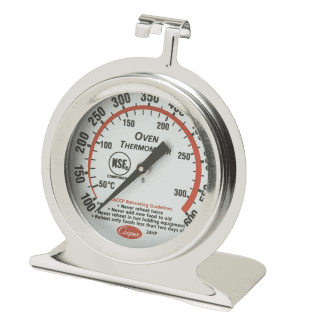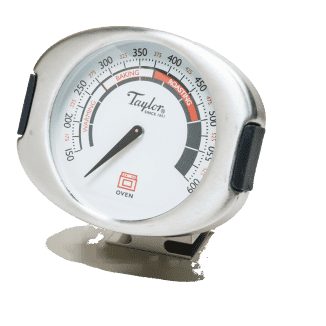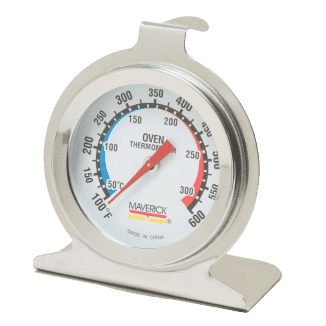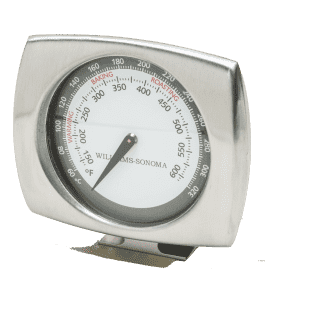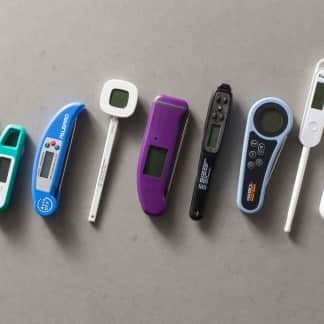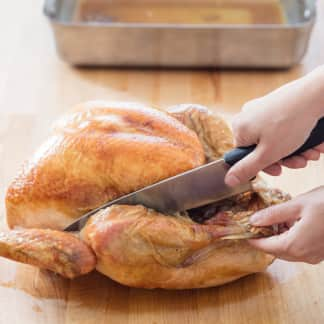The best oven thermometers are accurate and easy to use, letting you know if your oven temperatures are significantly off. In general, we prefer digital thermometers, as they are more precise and durable and can be used for other tasks besides taking oven temperatures. Our favorite is the ThermoWorks Square DOT; it’s especially easy to operate and has two probes, making it especially handy for tracking food and air temperatures. A less expensive digital option is the ThermoPro TP16; it’s got a few operational quirks but is impressively accurate. Conventional analog oven thermometers are still the cheapest way to check your oven temperatures. Our favorite is the CDN DOT2 - Oven Thermometer. It was consistently accurate and easy to read.

Does your soufflé fail to puff up to the tallest heights? Do your cookies brown too quickly—or spread out too much before they brown at all? Does the outside of your roast beef overcook before the inside comes up to temperature? If you’ve had any of these cooking or baking headaches, your oven might be to blame.
A good oven thermometer lets you test the accuracy of your oven’s temperature settings so that you can adjust them as needed. If the thermometer shows that your oven runs hot, you’ll want to decrease the temperature setting accordingly on your next oven foray. If it runs cold, you’ll increase that temperature.
How Do I Know If My Oven Temperatures Are Accurate?
In order to know what accuracy means for an oven, it’s important to understand a few things about how ovens work. First, you can’t always trust your oven to tell you when it’s ready—alerts are not always accurate. An oven’s internal thermometer only gauges the temperature of the location where it’s installed, which is necessarily in an out-of-the-way spot in the back, front, or side of the oven box. The trouble is, these areas don’t necessarily reflect the temperature at the center of the oven, where food cooks.
Second: Ovens don’t stay at the exact temperature you set for hours at a time. Instead, they cycle up and down through a range of temperatures around the target temperature. A well-calibrated oven can cycle through temperatures that are as much as 25 degrees above and below that target temperature. Over time, however, the temperature should average out to the one you’ve set.
But even ovens that aren’t perfectly calibrated can still work just fine. With most foods, you won’t notice even if your average oven temperature is off by as much as 25 degrees. Your cake or roast beef or potatoes will still be delicious and the cook time won’t be radically different from the ones you see in the recipe.
The problems start when your oven temperature cycle is off by more than 25 degrees, or when you’re trying to make quick-cooking baked goods such as cookies and foods that are especially sensitive to heat, including soufflés, popovers, or Dutch babies. The texture and rise of your food can be affected, and it can take significantly longer or shorter to cook these foods.
Does every home cook need to test their oven’s accuracy? Not necessarily. If you’ve had no issues with anything coming out of your oven, it’s safe to assume that your oven is reasonably accurate. But if you’ve had issues, you’ll want to find out just how inaccurate your oven is with an oven thermometer.
Does 25 Degrees Off Really Matter?
While your oven doesn’t always have to be at the exact recommended temperature when you’re roasting and baking most foods, there’s a much smaller margin of error when baking certain types of foods where temperature is critical to achieving the correct rise. Popovers, Dutch babies, and soufflés all require very specific temperatures in order to puff up properly. Oven temperatures can fluctuate within as much as 25 degrees of the target and still be considered accurate on average, as acknowledged by the standards of independent certification organization NSF International. The problem is when your oven temperature average is 25 degrees off from the target temperature. To see the impact of such a discrepancy, we baked popovers in ovens that we set to 25 degrees above and below the desired initial temperature of 450 degrees. The popovers in the too-cold oven didn’t rise properly, while those in the too-hot oven were misshapen and overly dark. If you make a lot of sensitive baked goods, you'll want to ensure that you test your oven's accuracy regularly, and adjust for any discrepancies as needed.
What are the different types of oven thermometers?
There are two basic kinds of oven thermometers: Analog (dial-face) oven thermometers and digital (leave-in) oven thermometers.

Analog Oven Thermometers
Analog oven thermometers are simple, inexpensive tools that hang from your oven rack or sit on top of them. They have large faces with a temperature dial on them. A bimetallic strip (that is, two pieces of different metals pressed together) inside the thermometer is wound into a tight coil and connected to a needle on the dial. The two metals expand and contract at different rates when heated or cooled, moving the needle around the dial as your oven heats up to indicate the temperature.
Analog thermometers take longer than digital thermometers to register changes in temperature, and they are much less precise, too—if you want to use one to get a measurement of your oven temperature at the exact moment you look at the dial, you’re out of luck. But this lack of speed and precision can actually be an advantage, since your oven can cycle through a wide range of temperatures over time. In effect, a good analog oven thermometer, properly preheated, gives you a reliable oven temperature average of the highs and lows in the cycle, providing you with a much more useful measure of how the oven is performing overall. (The slow response time also comes in handy if you have to open the oven door to read the analog thermometer to begin with—the needle won’t suddenly drop the moment you let cool air in, so you can still read it easily.)
That said, analog oven thermometers do have a major disadvantage: They’re relatively fragile and vulnerable to losing their calibration over time. We’ve also found that quality can vary from unit to unit, perhaps because of how the products are made at different factories. With three products, one out of the four copies we tested faltered, registering temperatures that were significantly off from the true average oven temperature.

Digital Oven Thermometers
By contrast, digital oven thermometers are much more durable and reliable and read temperatures much more quickly, accurately, and precisely. And they let you check your oven temperature without ever having to open the oven door. Simply attach the thermometer’s wire probe to a small display and snake the probe into the oven, draping it over the oven rack or attaching it to the rack with a clip. As the oven heats, you can track its temperature on the display. The one thing to keep in mind, though, is that because digital thermometers respond so quickly to temperature changes, most readouts reflect specific points within the oven’s temperature cycle. Don’t worry if you see that the temperature has dipped to 325 when it’s set to 350—this is perfectly normal within the rise and fall of most ovens’ heating cycles. As a rule of thumb, as long as the temperature consistently lands within 25 degrees of your target temperature, your oven is well-calibrated. If you want to get a precise value that indicates how hot your oven is when you set it to a specific temperature, track your oven temperature over 10 minutes to record the high and low ends of your oven’s temperature range and then average the two.
One of the big advantages to using a digital thermometer is that many cooks already have one. The same leave-in thermometer you use to track the temperature of your roast turkey or fry oil or caramel can also take the temperature of your oven. (Just make sure it’s safe to use at temperatures above 400 degrees if you plan to test your oven’s accuracy at higher heats.) The downside to digital thermometers? Because digital thermometers are more sophisticated instruments than analog versions, they cost significantly more.
Ultimately, both analog and digital models can work equally well for taking oven temperatures. In general, we prefer digital models, as they’re more versatile, more precise, and have better reliability and longevity. We think these qualities are worth spending more for. That said, if you want a budget-friendly option that provides an average snapshot of your oven’s performance, a simple analog thermometer will serve you just fine, at least for a few years.
What to Look For
- Accuracy and Reliability: As with all thermometers, accuracy and reliability are key. Our top-rated analog and digital oven thermometers provided accurate readouts at every oven temperature we tried. Better still, they were consistently accurate, with multiple copies of each thermometer registering correct temperatures.

- Stability: The best models stay put so that you can reliably take temperatures in a specific area of your oven. Overall, digital oven thermometer probes were easy to position in the oven using clips (usually purchased separately; see below) that sat snugly between oven rack slats to hold the probe in place. With analog models, we preferred those with wide bases measuring at least 2.5 inches across, as these sat especially securely on the oven racks. We also liked models with large loops that hooked securely around a variety of oven racks.

- Simple, Easy-to-Read Displays: All the digital thermometers we tested had clear displays that made it easy to tell exactly what temperature our oven had reached. With dial-face models, we preferred those with large, easy-to-read numbers. Our testers also favored models that had minimal markings beyond 50- and 25-degree indications, since having more tick marks made them harder to read, and the extra marks were unnecessary anyway.
What to Avoid
- Inaccuracy and Unreliability: An inaccurate, unreliable oven thermometer is worse than none at all. While all the digital thermometers we tested were accurate, the analog thermometers didn’t all fare as well. With three products, one out of the four copies faltered, registering average temperatures 10 to 25 degrees off the real average oven temperature. Fortunately, our top-rated analog thermometers were consistently accurate.
- Clamp-on Dial-Face Thermometers: We didn’t love models that clamped onto racks. The space between the open jaws of the clamps were too narrow to slide over the racks in all five of the different oven styles we tested. At best, they slid on crooked and were difficult to read. At worst, they fell off completely and landed on the oven floor. After one such tumble, the silicone backing on one model melted and warped. The glass face of another top-heavy model cracked when it hit the oven floor.
- Busy, Hard-to-Read Displays: Some analog models had numerals that were too small or difficult to read, with many tick marks crowding the display. We also knocked off points on analog models with metal casings that obscured the numbers or cast long shadows on them, forcing us to crouch or squint to read the temperature.
The Tests
- Check accuracy in ovens set to 250, 350, and 450 degrees Fahrenheit
- Evaluate ease of positioning
- Assess how hard/easy to knock off rack
- Check readability with oven door open and closed
How We Rated
- Accuracy: We rated the thermometers on how accurate they were at different temperatures.
- Legibility: We rated the thermometers on how easy they were to read.
- Stability: We rated the thermometers on how easily we were able to position and secure them within the oven.


 Buy at ThermoWorks
Buy at ThermoWorks












